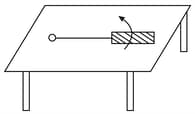A square metal wire loop of side and resistance is moved with a constant velocity in a uniform magnetic field perpendicular to the plane of the loop and directed inwards. The loop is connected to a network of resistors as shown. If the resistance of load wires and are negligible, find the speed of the loop required to get a current of
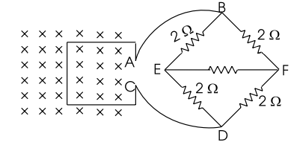

Important Questions on Electromagnetic Induction
[Assume the velocity of wire remains constant after key is closed. Given: where is base of the natural logarithm]
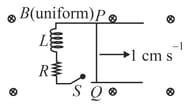
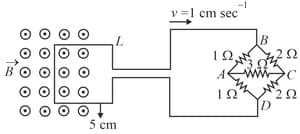
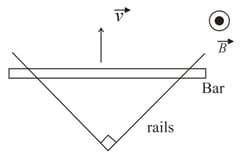
A rod of length slides with a speed of on a rectangular conducting frame as shown in figure. There exists a uniform magnetic field of perpendicular to the plane of the figure. If the resistance of the rod is . The current through the rod is
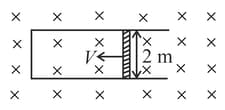
A thin strip long is on a shaped wire of negligible resistance and it is connected to a spring of spring constant (see figure). The assembly is kept in a uniform magnetic field of If the strip is pulled from its equilibrium position and released, the number of oscillations it performs before its amplitude decreases by a factor of is . If the mass of the strip is grams, its resistance and air drag negligible, will be close to:
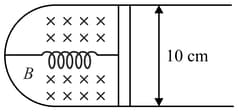
A square frame of side and a long straight wire carrying current are in the plane of the paper. Starting from close to the wire, the frame moves towards the right with a constant speed of (see figure). The e.m.f induced at the time the left arm of the frame is at from the wire is
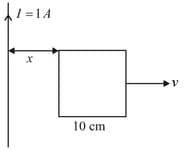

As shown in the figure, a rectangular loop of a conducting wire is moving away with a constant velocity in a perpendicular direction from a very long straight conductor carrying a steady current . When the breadth of the rectangular loop is very small compared to its distance from the straight conductor, how does the emf: induced in the loop vary with time

A horizontal rod of length rotates about a vertical axis with a uniform angular velocity . A uniform magnetic field exists parallel to the axis of rotation. Then potential difference between the two ends of the rod is
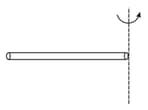
A conducting bar of length is free to slide on two parallel conducting rails as shown in the figure.
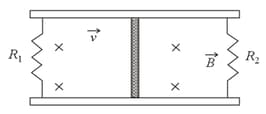
Two resistors and are connected across the ends of the rails. There is a uniform magnetic field pointing into the page. An external agent pulls the bar to the left at a constant speed .
The correct statement about the directions of induced currents and flowing through and respectively is :
A metallic rod of length is tied to a string of length and made to rotate with angular speed on a horizontal table with one end of the string fixed. If there is a vertical magnetic field B in the region, the e.m.f. induced across the ends of the rod is:
